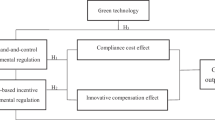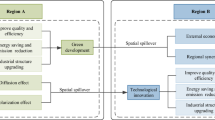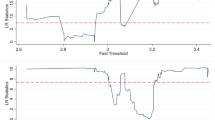Abstract
With the rapid development of mariculture, environmental pollution is becoming more and more serious. It is particularly important to study the green output bias of technological progress for the long-term sustainable development of mariculture. Based on the input–output data of the mariculture in 10 Chinese coastal areas from 2008 to 2018, the DEA-Malmquist index decomposition method is used to calculate the output-biased technological progress index and combines with the change of marginal substitution rate of output factors in different periods to identify the bias of technological progress between output factors and analyze the green output bias of mariculture technological progress. The results show that green technological progress is a crucial factor affecting green total factor productivity’s growth in China’s mariculture. During the study period, the number of regions where technological progress tends to reduce pollutant emissions shows a fluctuating upward trend, and the degree of technological progress toward green output is high. There are obvious differences among regions. The green output bias of technological progress in the South China Sea area is the highest, followed by the East China Sea area, and the Bohai Sea area is poor. Specifically, the green output bias of technological progress in Fujian, Guangdong, and Hainan is higher, while the green output bias of technological progress in Tianjin, Hebei, Shandong, and Guangxi is lower. According to the research results, corresponding policy suggestions are provided to realize the green and sustainable development of China’s mariculture.



Similar content being viewed by others
Data availability
Data and materials will be available from the corresponding author on reasonable request.
Change history
07 January 2023
A Correction to this paper has been published: https://doi.org/10.1007/s11356-022-25129-4
References
Acemoglu D (1998) Why do new technologies complement skills? Directed technological change and wage inequality. Q J Econ 113(4):1055–1089. https://www.jstor.org/stable/2586974
Acemoglu D (2007) Equilibrium bias of technology. Econometrica 75(5):1371–1409. https://doi.org/10.1111/j.1468-0262.2007.00797.x
Acemoglu D, Carvalho VM, Ozdaglar A, Salehi AT (2012) The network origins of aggregate fluctuations. Econometrica 80(5):1977–2016. https://doi.org/10.3982/ECTA9623
Ahmed EM (2020) Modelling green productivity spillover effects on sustainability. World Journal of Science, Technology and Sustainable Development 17(3):257–267. https://doi.org/10.1108/WJSTSD-01-2020-0009
Aripin A, Coglan L, Pascoe S, Hoang VN (2020) Productive efficiency and capacity utilization of sea bass grow-out culture in peninsular Malaysia. Aquac Econ Manag 24(1):102–121. https://doi.org/10.1080/13657305.2019.1661045
Barros CP, Weber WL (2009) Productivity growth and biased technological change in UK ariports. Transp Policy 45(4):642–653. https://doi.org/10.1016/j.tre.2009.01.004
Battese GE (1992) Frontier production functions and technical efficiency: a survey of empirical applications in agricultural economics. Agric Econ 7(3–4):185–208. https://doi.org/10.1111/j.1574-0862.1992.tb00213.x
Chang YC, Yu MM (2014) Measuring physical productivity growth and biased technological change in Chinese airports. Int J Transp Econ. XLI(1):51-74. https://doi.org/10.1400/220027
Chen YB, Song GB, Zhao WX, Chen JW (2016) Pollution load estimation of mariculture in China. Mar Environ Sci 35 (01):1–6+12 (In Chinese). https://doi.org/10.13634/j.cnki.mes.2016.01.001
Cheng ZH, Li LS, Liu J (2021) Research on China’s industrial green biased technological progress and its energy conservation and emission reduction effects. Energy Efficiency 14(5). https://doi.org/10.1007/s12053-021-09956-x
Chung YH, Färe R, Grosskopf S (1997) Productivity and undesirable outputs: a directional distance function approach. J Environ Manage 51(3):229–240. https://doi.org/10.1006/jema.1997.0146
Dey MM, Paraguas FJ, Bimbao GB et al (2000) Technical efficiency of tilapia growout pond operations in the Philippines. Aquac Econ Manag 4(1):33–47. https://doi.org/10.1080/13657300009380259
Dissou Y, Karnizova L, Sun Q (2012) Industry-level econometric estimates of energy-capital-labor substitution with a nested CES production function. Atl Econ J 42(1):1–15. https://doi.org/10.1007/s11293-014-9443-1
Dupuy A (2006) Hicks neutral technological change revisited: CES production function and information of general order. Top Macroecon 6(2):339–1339. https://doi.org/10.2202/1534-5998.1339
Färe R, Grifell-Tatjé E, Grosskopf S, Lovell CAK (1997) Biased technical change and the malmquist productivity index. Scandinavian J Econ 99(1):119–127. https://doi.org/10.1111/1467-9442.00051
Greaker M, Heggedal TR, Rosendahl KE (2018) Environmental policy and the direction of technological change. Scandinavian Journal of Economics 120(4):1100–1138. https://doi.org/10.1111/sjoe.12254
Han HY, Ye J (2019) The evolution of mariculture structures and environmental effects in China. J Coastal Res 83(sp1):155–166. https://doi.org/10.2112/SI83-024.1
Hassanpour B, Ismail MM, Mohamed Z, Kamarulzaman NH (2010) Sources of productivity growth in rainbow trout aquaculture in Iran: technological efficiency change or technological progress? Aquac Econ Manag 14(3):218–234. https://doi.org/10.1080/13657305.2010.503474
Hayami Y, Ruttan VW (1971) Agricultural development: an international perspective. The Johns Hopkins Press, Baltimore, Md/London
Hicks JRS (1932) The theory of wages. Macmillan
Karagiannis G, Katranidis SD, Tzouvelekas V (2000) Measuring technical, allocative and cost efficiencies of seabass and seabream farms in Greece. Aquac Econ Manag 4(3–4):191–207. https://doi.org/10.1080/13657300009380269
Karanfil F, Yeddir-Tamsamani Y (2010) Is technological change biased toward energy? A multi-sectoral analysis for the French economy. Energy Policy 38(4):1842–1850. https://doi.org/10.1016/j.enpol.2009.11.061
Kawagoe T, Otsuka K, Hayami Y (1986) Induced bias of technical change in agriculture: the United States and Japan, 1880–1980. Journal of Political Economy 94(3, Part 1):523–544. https://doi.org/10.1086/261388
Kendrick JW (1973) Productivity trends. Bus Econ 8(1):56–61. http://www.jstor.org/stable/23481441
Klinger D, Naylor R (2012) Searching for solutions in aquaculture: charting a sustainable course. Annu Rev Environ Resour 37:247–276. https://doi.org/10.1146/annurev-environ-021111-161531
Klump R, Mcadam P, Willman A (2007) Factor substitution and factor-augmenting technological progress in the united states: a normalized supply-side system approach. Rev Econ Stat 89(1):183–192. https://doi.org/10.1162/rest.89.1.183
Lawrence RZ (1996) North-South trade, employment, and inequality: changing fortunes in a skill-driven world by Adrian Wood. ILR Rev 49(3):567–569. https://doi.org/10.1177/001979399604900323
Li J, See KF, Chi J (2019) Water resources and water pollution emissions in China’s industrial sector: a green-biased technological progress analysis. J Clean Prod 229:1412–1426. https://doi.org/10.1016/j.jclepro.2019.03.216
Managi S, Karemera D (2004) Input and output biased technological change in US agriculture. Appl Econ Lett 11(5):283–286. https://doi.org/10.1080/1350485042000221526
Martinez-Cordero FJ, Leung PS (2004) Sustainable aquaculture and producer performance: measurement of environmentally adjusted productivity and efficiency of a sample of shrimp farms in Mexico. Aquaculture 241(1):249–268. https://doi.org/10.1016/j.aquaculture.2004.07.028
Nielsen R (2011) Green and technological efficient growth in Danish fresh water aquaculture. Aquac Econ Manag 4:1365–7305. https://doi.org/10.1080/13657305.2011.624574
Nielsen M, Ravensbeck L, Nielsen R (2014) Green growth in fisheries. Mar Policy 46:43–52. https://doi.org/10.1016/j.marpol.2014.01.003
Ren WH,Zeng Q (2021) Is the green technological progress bias of mariculture suitable for its factor endowment? —empirical results from 10 coastal provinces and cities in China. Mar Policy 124:104338. https://doi.org/10.1016/j.marpol.2020.104338
Sanstad AH, Roy J, Sathaye JA (2006) Estimating energy-augmenting technological change in developing country industries. Energy Economics 28(5–6):720–729. https://doi.org/10.1016/j.eneco.2006.07.005
Sato R, Morita T (2009) Quantity or quality: the impact of labour saving innovation on US and Japanese growth rates 1960–2004. Japanese Economic Review 60(4):407–434. https://doi.org/10.1111/J.1468-5876.2008.00467.X
Schwitzguébel JP, Wang HL (2007) Environmental impact of aquaculture and countermeasures to aquaculture pollution in China. Environmental Science and Pollution Research - International 14(7):452–462. https://doi.org/10.1065/espr2007.05.426
Shi XA, Li LS (2019) Green total factor productivity and its decomposition of Chinese manufacturing based on the MML index:2003–2015. J Clean Prod 222:998–1008. https://doi.org/10.1016/j.jclepro.2019.03.080
Singh K (2008) Farm specific economic efficiency of fish production in South Tripura District: a stochastic frontier approach. Indian Journal of Agricultural Economics 63(4):598–613
Singh P, Singh A (2012) Decomposition of technical change and productivity growth in Indian agriculture using non-parametric Malmquist index. Eurasian J Bus Econ 5(9):187-202. https://doi.org/10.21648/arthavij/2014/v56/i4/111174
Sun YN, Ji JY (2021) Measurement and analysis of technological progress bias in China’s mariculture industry. J World Aquaculture Soc 53:1–17. https://doi.org/10.1111/jwas.12866
Taylor TG, Shonkwiler JS (1986) Alternative stochastic specifications of the frontier production function in the analysis of agricultural credit programs and technical efficiency. J Dev Econ 21(1):149–160. https://doi.org/10.1016/0304-3878(86)90044-1
Vassdal T, Holst HMS (2011) Technological progress and regress in Norwegian salmon farming: a Malmquist index approach. Mar Resour Econ 26(4):329–341. https://doi.org/10.5950/0738-1360-26.4.329
Wang JT, Wang XZ, Gao F (2007) Estimation of national and provincial agricultural capital stock K. Agricultural Technology and Economy 04:64–70 ((In Chinese))
Wang C, Liao H, Pan SY, Zhao L, Wei Y (2014) The fluctuations of China’s energy intensity: biased technical change. Appl Energy 135:407–414. https://doi.org/10.1016/j.apenergy.2014.06.088
Wang ZL, Xiao J, Fan SL, Li Y, Liu XQ, Liu DY (2015) Who made the world’s largest green tide in China?—an integrated study on the initiation and early development of the green tide in Yellow Sea. Limnol Oceanogr 60:1105–1117. https://doi.org/10.1002/lno.10083
Weber WL, Domazlicky BR (1998) Total factor productivity growth in manufacturing: a regional approach using linear programming. Reg Sci Urban Econ 29(1):105–122. https://doi.org/10.1016/S0166-0462(98)00013-1
Xu J, Han LM, Yin W (2022) Research on the ecologicalization efficiency of mariculture industry in China and its influencing factors. Mar Policy 137:104935. https://doi.org/10.1016/j.marpol.2021.104935
Yu MM, Hsu CC (2012) Service productivity and biased technological change of domestic airports in Taiwan. Int J Sustain Transp 6(1):1–25. https://doi.org/10.1080/15568318.2010.551577
Yu X, Hu QG, Shen MH (2020) provincial differences and dynamic changes in mariculture efficiency in China: based on super-SBM model and global Malmquist index. Biology 9(1):18. https://doi.org/10.3390/biology9010018
Zong HM, Yuan XT, Wang LJ, Yu LM, Hu YY, Huo CL, Zhang ZF (2017) Preliminary assessment of nitrogen and phosphorus production in mariculture in China. Marine environmental science 36(03):336–342 (In Chinese). https://doi.org/10.13634/j.cnki.mes.2017.03.003
Funding
The work was supported by the National Natural Science Foundation of China, Grant Number 71873127; the National Social Science Fund of China, Grant Number 19VHQ007; and the Shandong Social Science Planning Project, Grant Number 20AWTJ19.
Author information
Authors and Affiliations
Contributions
Jianyue Ji: conceptualization and formal analysis. Yanan Sun: data curation, investigation, methodology, software, visualization, writing—original draft. Xingmin Yin: writing—review and editing. All authors have read and agreed to the published version of the manuscript.
Corresponding author
Ethics declarations
Ethics approval and consent to participate
Not applicable.
Consent for publication
Not applicable.
Competing interests
The authors declare no competing interests.
Additional information
Responsible Editor: Philippe Garrigues
Publisher's note
Springer Nature remains neutral with regard to jurisdictional claims in published maps and institutional affiliations.
Rights and permissions
Springer Nature or its licensor (e.g. a society or other partner) holds exclusive rights to this article under a publishing agreement with the author(s) or other rightsholder(s); author self-archiving of the accepted manuscript version of this article is solely governed by the terms of such publishing agreement and applicable law.
About this article
Cite this article
Ji, J., Sun, Y. & Yin, X. Study on green output bias of China’s mariculture technological progress. Environ Sci Pollut Res 29, 60558–60571 (2022). https://doi.org/10.1007/s11356-022-20158-5
Received:
Accepted:
Published:
Issue Date:
DOI: https://doi.org/10.1007/s11356-022-20158-5




